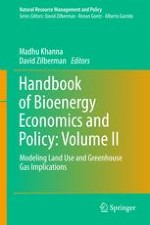2017 | OriginalPaper | Chapter
Land Use and Greenhouse Gas Implications of Biofuels: Role of Technology and Policy
Authors : Xiaoguang Chen, Madhu Khanna
Published in: Handbook of Bioenergy Economics and Policy: Volume II
Publisher: Springer New York
Activate our intelligent search to find suitable subject content or patents.
Select sections of text to find matching patents with Artificial Intelligence. powered by
Select sections of text to find additional relevant content using AI-assisted search. powered by
